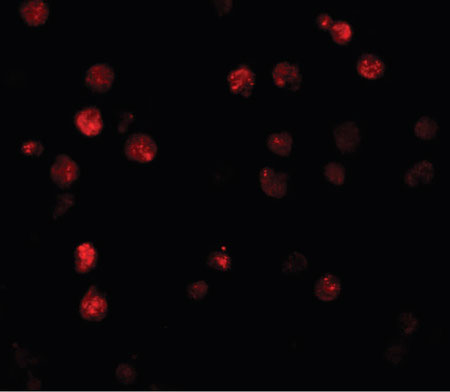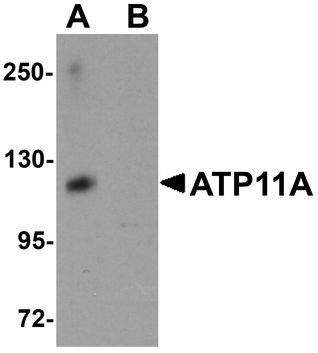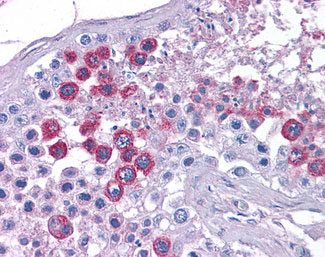ATP11A Antibody (N-Terminus)
Rabbit Polyclonal Antibody
- SPECIFICATION
- CITATIONS
- PROTOCOLS
- BACKGROUND

Application
| WB, IHC-P, IF, ICC, E |
|---|---|
| Primary Accession | P98196 |
| Reactivity | Human, Mouse, Rat |
| Host | Rabbit |
| Clonality | Polyclonal |
| Calculated MW | 130kDa |
| Dilution | IHC-P (5 µg/ml), WB (1-2 µg/ml), |
| Gene ID | 23250 |
|---|---|
| Other Names | Probable phospholipid-transporting ATPase IH, 3.6.3.1, ATPase IS, ATPase class VI type 11A, P4-ATPase flippase complex alpha subunit ATP11A, ATP11A, ATPIH, ATPIS, KIAA1021 |
| Target/Specificity | Human ATP11A |
| Reconstitution & Storage | Short term 4°C, long term aliquot and store at -20°C, avoid freeze thaw cycles. Store undiluted. |
| Precautions | ATP11A Antibody (N-Terminus) is for research use only and not for use in diagnostic or therapeutic procedures. |
| Name | ATP11A |
|---|---|
| Synonyms | ATPIH, ATPIS, KIAA1021 |
| Function | Catalytic component of a P4-ATPase flippase complex which catalyzes the hydrolysis of ATP coupled to the transport of aminophospholipids, phosphatidylserines (PS) and phosphatidylethanolamines (PE), from the outer to the inner leaflet of the plasma membrane (PubMed:25315773, PubMed:25947375, PubMed:26567335, PubMed:29799007, PubMed:30018401, PubMed:36300302). Does not show flippase activity toward phosphatidylcholine (PC) (PubMed:34403372). Contributes to the maintenance of membrane lipid asymmetry with a specific role in morphogenesis of muscle cells. In myoblasts, mediates PS enrichment at the inner leaflet of plasma membrane, triggering PIEZO1-dependent Ca2+ influx and Rho GTPases signal transduction, subsequently leading to the assembly of cortical actomyosin fibers and myotube formation (PubMed:29799007). May be involved in the uptake of farnesyltransferase inhibitor drugs, such as lonafarnib. |
| Cellular Location | Cell membrane; Multi-pass membrane protein. Early endosome. Recycling endosome. Endoplasmic reticulum membrane; Multi-pass membrane protein. Note=Efficient exit from the endoplasmic reticulum requires the presence of TMEM30A. |
| Tissue Location | Widely expressed (PubMed:26567335). Expressed in myoblasts (PubMed:29799007). |

Thousands of laboratories across the world have published research that depended on the performance of antibodies from Abcepta to advance their research. Check out links to articles that cite our products in major peer-reviewed journals, organized by research category.
info@abcepta.com, and receive a free "I Love Antibodies" mug.
Provided below are standard protocols that you may find useful for product applications.
Background
Catalytic component of a P4-ATPase flippase complex which catalyzes the hydrolysis of ATP coupled to the transport of aminophospholipids from the outer to the inner leaflet of various membranes and ensures the maintenance of asymmetric distribution of phospholipids. Phospholipid translocation seems also to be implicated in vesicle formation and in uptake of lipid signaling molecules (Probable). May be involved in the uptake of farnesyltransferase inhibitor drugs, such as lonafarnib.
References
Dunham A.,et al.Nature 428:522-528(2004).
Kikuno R.,et al.DNA Res. 6:197-205(1999).
Ohara O.,et al.Submitted (AUG-2005) to the EMBL/GenBank/DDBJ databases.
Zhang B.,et al.Blood 106:1355-1361(2005).
Takatsu H.,et al.J. Biol. Chem. 286:38159-38167(2011).
If you have used an Abcepta product and would like to share how it has performed, please click on the "Submit Review" button and provide the requested information. Our staff will examine and post your review and contact you if needed.
If you have any additional inquiries please email technical services at tech@abcepta.com.













 Foundational characteristics of cancer include proliferation, angiogenesis, migration, evasion of apoptosis, and cellular immortality. Find key markers for these cellular processes and antibodies to detect them.
Foundational characteristics of cancer include proliferation, angiogenesis, migration, evasion of apoptosis, and cellular immortality. Find key markers for these cellular processes and antibodies to detect them. The SUMOplot™ Analysis Program predicts and scores sumoylation sites in your protein. SUMOylation is a post-translational modification involved in various cellular processes, such as nuclear-cytosolic transport, transcriptional regulation, apoptosis, protein stability, response to stress, and progression through the cell cycle.
The SUMOplot™ Analysis Program predicts and scores sumoylation sites in your protein. SUMOylation is a post-translational modification involved in various cellular processes, such as nuclear-cytosolic transport, transcriptional regulation, apoptosis, protein stability, response to stress, and progression through the cell cycle. The Autophagy Receptor Motif Plotter predicts and scores autophagy receptor binding sites in your protein. Identifying proteins connected to this pathway is critical to understanding the role of autophagy in physiological as well as pathological processes such as development, differentiation, neurodegenerative diseases, stress, infection, and cancer.
The Autophagy Receptor Motif Plotter predicts and scores autophagy receptor binding sites in your protein. Identifying proteins connected to this pathway is critical to understanding the role of autophagy in physiological as well as pathological processes such as development, differentiation, neurodegenerative diseases, stress, infection, and cancer.





